Manual work has a cost. It doesn’t always show up on your balance sheet or in monthly reports, but it’s there hiding in long workdays, stalled projects, and stretched teams. Businesses that rely on people to bridge gaps between systems often don’t notice the drag until it’s too late.

The Cumulative Weight of Manual Processes
At first, it might seem harmless. A spreadsheet here, a copy-paste task there. Maybe someone on your team has figured out a few workarounds that “get the job done.” But when your operations rely on manual actions to function, those clicks start stacking up. From data entry to approval chains, manual work eats away at hours that could be spent on more valuable work.
And the same outcomes:
- Long response times
- Missed handoffs
- Delayed reporting
- Exhausted teams
It’s not just about time; it’s about attention and accuracy. When smart people are stuck doing routine work, they’re not solving problems or driving growth.
Why the Real Cost Is Bigger Than You Think
Manual work introduces friction at scale. It slows down momentum and makes growing your business harder than it needs to be.
You lose out on:
- Faster service delivery
- Consistent customer experience
- Real-time visibility into performance
- Headcount flexibility
- Decision-making based on current data
Most importantly, you lose time, something you can’t get back. By the time a report gets finalized or a deal gets approved manually, the opportunity may already be gone.
Business Automation Isn’t Just for Big Enterprises
There’s a misconception that automation is complicated, expensive, or only for large companies. That’s not the case anymore.
Modern business automation allows any organization to:
- Connect systems that don’t talk to each other
- Eliminate repetitive tasks across departments
- Centralize workflows into clean, trackable pipelines
- Send alerts or escalations when actions are needed
- Keep records organized without depending on email chains
It’s not about removing people; it’s about giving your team space to work smarter.
Key Signs You’re Ready for Automation
Some signs are easy to overlook because they feel normal. But when your team starts saying things like
- “We have to update this in three places.”
- “We’re still waiting for approval before we can move.”
- “This report takes two days to compile.”
- “We always double-check because something might go wrong.”
It’s a signal that automation could remove friction and improve your operations. These issues don’t get smaller as your business grows; they multiply.
The Compounding Benefits of Automation
Once automation is in place, the impact isn’t subtle. Tasks that took hours now happen in seconds. Data gets where it needs to go without needing a middleman. Leaders get real-time dashboards instead of end-of-week recaps.
And when a new process rolls out? It can be built right into your systems; no more email training sessions or long handoffs.
Why It Pays to Start Now
Waiting to automate means spending more on inefficiency. You’re essentially paying employees to do what software can handle in the background.
Small process gaps today become growth blockers tomorrow. The longer you delay, the more you rely on workarounds that drain your time, create confusion, and lower the ceiling on how far your team can scale.
From Manual to Modern: How Devfinity Helps You Scale
At Devfinity, we build business automation solutions that match how your teams actually work. We help connect your systems, automate repetitive actions, and create smarter workflows that make scaling possible without the chaos.
You don’t need a complete system overhaul to get started. We identify the biggest time drains, then implement solutions that make a difference quickly, while laying a foundation you can build on as you grow.
Ready to Eliminate the Invisible Costs?
You shouldn’t have to build your business around manual processes. Let’s talk about what’s slowing your team down and how automation can get you back on track.
Contact Devfinity about building smarter, scalable systems for your business.
RELATED Articles
Custom software promises to solve unique business challenges, but too often it
Artificial intelligence is the backbone of modern business transformation. From predictive analytics
Automation is no longer a buzzword; it’s a business necessity. From reducing
First impressions matter, especially online. Your website is often the first interaction
Launching a new product is a race against time. Competitors are pushing
Websites don’t get second chances. The moment someone lands on your site,






